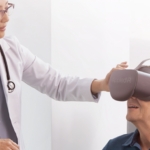Games For Change releases social impact-driven XR landscape survey at the 2020 Unity for Humanity Summit.
Over the past decade, extended reality technologies (XR)—including augmented, mixed, and virtual reality—have graduated from the stuff of science fiction to that of mainstream reality. Games like Pokémon GO and Beat Saber have acclimated people outside of narrow insider communities to the potential of XR—in both gaming and non-gaming applications—as we push into the 2020s.
But while XR is increasingly included in conversations around possible zones of innovation, oftentimes it can be hard to understand the unique opportunities and risks associated with actually developing solutions using these technologies. This is particularly true for realms outside of games and entertainment, where value oftentimes needs to be established from the outset in order to justify the upfront investment of time and resources.
A new white paper from Games For Change, officially presented today at the Unity for Humanity Summit, seeks to offer a toolkit for understanding the unique affordances of XR through advances in three social impact spaces: Education, Healthcare, and Workforce Training [Disclosure: the author has curated Games For Change event programming but was not involved in the creation of this white paper]. The report, written by Archit Kaushik, aims to “untangle the wide net of applications cast by impact-driven XR for various stakeholders interested in engaging with this technology.” Its insights pull from subject matter expert interviews, existing research, and industry use cases.
“At G4C, we recognized that a lot of folks in our community were struggling to get up to speed with all of the rapid developments happening in this space,” said Raul Carvajal, XR for Change lead and production manager at Games For Change, in an interview with the author. “People may have heard the hype around virtual reality and other XR technologies set to change the world, but it’s difficult to get a nuanced understanding of what that means in practice. With this report, we wanted to communicate that nuance through some of the awesome use cases that we’ve come across over the last three years.”
Healthcare
The first industry referenced in “XR for Social Impact” is healthcare. Healthcare spending currently accounts for 18% of the US GDP, and spending in this vertical was already projected to rise prior to the Covid-19 pandemic. Since then, consumer spending in telehealth has increased by 46%. XR, which can increase presence in virtual settings, offers several key advantages for healthcare practitioners.
“From cognitive therapy to physical therapy to pain relief, XR is quickly transforming the healthcare industry, changing the way doctors provide care to patients,” the report reads, outlining the following six areas in which XR is impacting healthcare:
- Access to Healthcare
- Pain Management
- Psychological Therapy
- Anatomical Visualization
- Medical Education
- Physical Fitness & Rehabilitation

Education
Immersive media technologies offer the potential for deep engagement. As such, they provide opportunities to improve education at a time when many around the world are highlighting an urgent need to reimagine learning to accommodate learners regardless of ability level, birthplace, or economic status.
“According to World Bank research, the world is facing a learning crisis,” the report states. “Their latest research shows that the productivity of 56% of the world’s children will be less than half of what it could be if they enjoyed complete education and full health. The healthcare crisis is also invariably linked to the poor performance of the education system … Although still nascent, XR will be a useful tool in addressing the learning crisis by transforming how students interact and learn about the world, catering to needs of students with different learning styles, motivations and cognitive capacities.”
XR aligns with several key areas to potentially address some of these pressing national and global issues.
- Motivation and Engagement
- Cognitive Load Reduction
- Experiential Learning
- Personalized Learning
- Fostering Empathy
- Cost Reduction
- Teacher Training
Workplace Training
The final section in the white paper regards workplace training. Companies around the world, including Wal-Mart, had already turned to VR as a means of training its workforce prior to the pandemic. But in the wake of shelter-in-place orders—and in the face of other possible shutdowns brought on by human and natural disasters in the future—companies are now waking up to the reality that virtual training infrastructure might have suddenly progressed from nice-to-have to must-have.
“The year 2020 has ushered several transformations in the workplace,” the report states. “COVID-19 has forced entire offices to rapidly transition to remote work environments. Employers and employees have had to develop strategies to effectively communicate and collaborate remotely. Social distancing protocols have forced companies to reconsider how they recruit, train and upskill talent. Companies are also increasingly launching workplace training that addresses racial bias and diversity, equity and inclusion efforts. As companies struggle to keep up with the pace of change, several are turning to XR as a new way of addressing some of these issues.”
Important use cases identified in the report of XR in workplace training include:
- Remote Communication and Collaboration
- Hard Skill Training
- Soft Skill Training
- Emergency Training
- Reducing Human Error
Each of these social impact areas is explained in greater detail in the report, with the purported goal of providing value for industry insiders and newcomers alike.
“We anticipate plenty of people reading who are curious about how they can apply this technology to achieve their own social impact goals, be that at an organizational level or as individuals,” Carvajal said. “It takes a lot of intention and ethically-aligned practice on behalf of creators to design an experience with the goal of making us better people. The work we highlighted in the report shows how powerful that intentionality can be, and I’m really excited at the possibility of sparking that in our readers.”
The full white paper can be found here.
Quelle:
Foto: Games For Change releases its „XR For Social Impact“ white paper at Unity for the Humanity Summit … [+]Embodied Labs, Inc.


